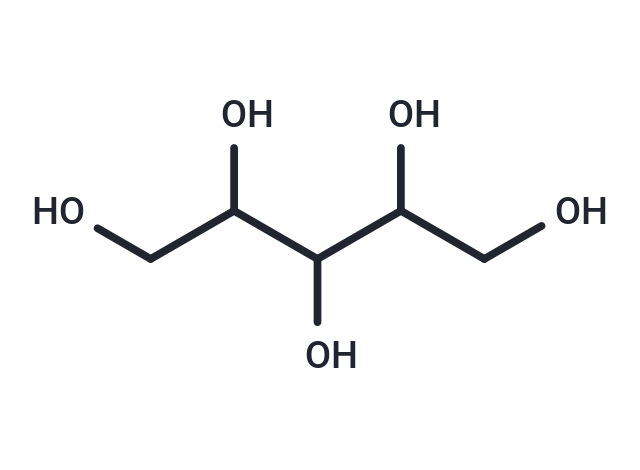Shopping Cart
- Remove All
 Your shopping cart is currently empty
Your shopping cart is currently empty

Ribitol is a pentitol that can be formed by ribose reduction. Enhancement of the D-glucose to pentose phosphate pathway in Saccharomyces cerevisiae can be used to produce ribitol and D-ribose.

| Pack Size | Price | Availability | Quantity |
|---|---|---|---|
| 500 mg | $30 | In Stock |
| Description | Ribitol is a pentitol that can be formed by ribose reduction. Enhancement of the D-glucose to pentose phosphate pathway in Saccharomyces cerevisiae can be used to produce ribitol and D-ribose. |
| In vitro | Ribitol is a crystalline pentose alcohol. [1] Ribitol is characterized from the plant Adonis vernalis. [2] Ribitol in 10% NFSM suspending medium exerts 1.45 to 2.18 times the protective effect exerted by glycerol at equal concentration. The cryoprotective action of Ribitol reaches its highest level at 0.75 M. For 11 of the 13 organisms tested including S. lactis T164, the degree of protection conferred by Ribitol is >80%. Ribitol has a strong protective effect on lactic acid bacteria during freeze-drying. [3] |
| Kinase Assay | The high-performance liquid chromatography (HPLC) analyses are carried out using a Fast Acid Column (100×7.8 mm) and a HPX-87H Ion Exclusion Column (300 mm×7.8 mm) in series with 2.5 mM H2SO4 in water as the mobile phase at a flow rate of 0.3 mL/min, at 55°C. This method enabled quantification of D-glucose, ethanol, glycerol, D-xylulose, Ribitol, and xylitol. D-ribose, D-ribulose, and D-arabitol coeluted on the Aminex HPX-87H column. The CarboPac MA-1 column of Dionex ICS-3000 is used to analyze representative culture supernatant samples for the presence of arabitol and xylitol. Samples are run at column temperature of 30°C with 480 mM NaOH at flow rate 0.4 mL/min. The CarboPac MA-1 column separated D-arabitol from D-ribose and D-ribulose, but the alkaline conditions degraded D-ribulose interfering with the quantification of D-ribose.Yeast cells are disrupted with glass beads in 100 mM sodium phosphate buffer pH 7.0 containing phenylmethylsulfonyl fluoride and pepstatin A in final concentrations of 0.17 mg/mL and 0.01 mg/mL, respectively.The activity of NAD+-dependent Gdh2p is measured in a reaction buffer of 0.5 M triethanol amine pH 7.7 and 2 mM NADH. After addition of the cell lysate, the reaction is started by adding a mixture of α-ketoglutarate (100 mM) and NH4Cl (200 mM) to a final concentration of 2.4 mM and 4.9 mM, respectively. The GapB activity is measured. Shortly, the reaction mixture is 500 mM triethanol amine pH 7.8, 1 mM ATP, 2 mM MgCl2, 200 μM NADPH, and 10 μg/mL of phosphoglycerate kinase. 3-phosphoglycerate is added to a final concentration of 5 mM to start the reaction. Activity measurements are performed with a Cobas Mira Plus automated analyzer[2]. |
| Alias | Adonitol, Adonite |
| Molecular Weight | 152.15 |
| Formula | C5H12O5 |
| Cas No. | 488-81-3 |
| Smiles | C(C(CO)O)(C(CO)O)O |
| Relative Density. | 1.1497 g/cm3 (Estimated) |
| Storage | Powder: -20°C for 3 years | In solvent: -80°C for 1 year | Shipping with blue ice. | |||||||||||||||||||||||||
| Solubility Information | H2O: 6.2 mg/mL (40.75 mM), Sonication is recommended. | |||||||||||||||||||||||||
Solution Preparation Table | ||||||||||||||||||||||||||
H2O
| ||||||||||||||||||||||||||

Copyright © 2015-2025 TargetMol Chemicals Inc. All Rights Reserved.